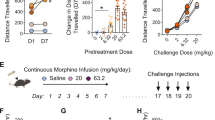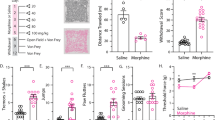Abstract
Stopping opioid medications can result in a debilitating withdrawal syndrome in chronic users. Opioid withdrawal can occur at all ages, but mechanistic understanding of this condition is predominantly derived from adult studies. Here, we examined whether there are age-dependent differences in the behavioural phenotype and cellular indices of opioid withdrawal. We tested this by assessing the behavioural and cFos response (a surrogate marker for neuronal activation) to morphine withdrawal in C57BL/6J mice across key developmental stages—neonatal, adolescent, and adulthood. Mice in all age groups received escalating doses of morphine (10–50 mg/kg) over 5 days and withdrawal was precipitated by a single injection of the opioid receptor antagonist naloxone (2 mg/kg) two hours after the last morphine dose. In adult and adolescent mice, withdrawal behaviours were robust, with age-related differences in autonomic and somatic signs. In both groups, cFos expression was increased in spinally projecting neurons within the Periaqueductal Grey (PAG), Rostro-ventromedial Medulla (RVM), and Locus Coeruleus. Neonatal animals displayed both a distinct behavioural withdrawal and cFos expression profile. Notably, in young animals cFos expression was increased within the PAG and LC, but decreased in the RVM. In summary, naloxone challenge precipitated robust opioid withdrawal behaviours across all developmental stages with neonatal animals displaying differences in withdrawal behaviours and unique neuronal activation patterns within key brainstem regions.





Similar content being viewed by others
Data Availability
Datasets and materials generated during and/or analysed during the current study are available from the corresponding author on reasonable request.
References
Altman J, Sudarshan K (1975) Postnatal development of locomotion in the laboratory rat. Anim Behav 23:896–920. https://doi.org/10.1016/0003-3472(75)90114-1
Anand KJ et al (2008) Morphine pharmacokinetics and pharmacodynamics in preterm and term neonates: secondary results from the NEOPAIN trial. Br J Anaesth 101:680–689. https://doi.org/10.1093/bja/aen248
Anand KJ et al (2010) Tolerance and withdrawal from prolonged opioid use in critically ill children. Pediatrics 125:e1208-1225. https://doi.org/10.1542/peds.2009-0489
Bagley EE, Chieng BC, Christie MJ, Connor M (2005) Opioid tolerance in periaqueductal gray neurons isolated from mice chronically treated with morphine. Br J Pharmacol 146:68–76. https://doi.org/10.1038/sj.bjp.0706315
Bailey CP, Connor M (2005) Opioids: cellular mechanisms of tolerance and physical dependence. Curr Opin Pharmacol 5:60–68. https://doi.org/10.1016/j.coph.2004.08.012
Beland B, Fitzgerald M (2001) Mu- and delta-opioid receptors are downregulated in the largest diameter primary sensory neurons during postnatal development in rats. Pain 90:143–150. https://doi.org/10.1016/s0304-3959(00)00397-3
Bie B, Peng Y, Zhang Y, Pan ZZ (2005) cAMP-mediated mechanisms for pain sensitization during opioid withdrawal. J Neurosci 25:3824–3832. https://doi.org/10.1523/JNEUROSCI.5010-04.2005
Boggess T, Risher WC (2020) Clinical and basic research investigations into the long-term effects of prenatal opioid exposure on brain development. J Neurosci Res. https://doi.org/10.1002/jnr.24642
Bouwmeester NJ, Hop WC, van Dijk M, Anand KJ, van den Anker JN, Tibboel D (2003) Postoperative pain in the neonate: age-related differences in morphine requirements and metabolism. Intensive Care Med 29:2009–2015. https://doi.org/10.1007/s00134-003-1899-4
Brust V, Schindler PM, Lewejohann L (2015) Lifetime development of behavioural phenotype in the house mouse (Mus musculus). Front Zool 12(Suppl 1):S17. https://doi.org/10.1186/1742-9994-12-S1-S17
Burke NN, Trang T (2017) Neonatal injury results in sex-dependent nociceptive hypersensitivity and social behavioral deficits during adolescence, without altering morphine response. J Pain 18:1384–1396. https://doi.org/10.1016/j.jpain.2017.07.003
Burma NE et al (2017a) Blocking microglial pannexin-1 channels alleviates morphine withdrawal in rodents. Nat Med 23:355–360. https://doi.org/10.1038/nm.4281
Burma NE, Kwok CH, Trang T (2017b) Therapies and mechanisms of opioid withdrawal. Pain Manag 7:455–459. https://doi.org/10.2217/pmt-2017-0028
Chambers RA, Taylor JR, Potenza MN (2003) Developmental neurocircuitry of motivation in adolescence: a critical period of addiction vulnerability. Am J Psychiatry 160:1041–1052. https://doi.org/10.1176/appi.ajp.160.6.1041
Chen HH et al (2015) Buprenorphine, methadone, and morphine treatment during pregnancy: behavioural effects on the offspring in rats. Neuropsychiatr Dis Treat 11:609–618. https://doi.org/10.2147/NDT.S70585
Colombini N, Elias R, Busuttil M, Dubuc M, Einaudi MA, Bues-Charbit M (2008) Hospital morphine preparation for abstinence syndrome in newborns exposed to buprenorphine or methadone. Pharm World Sci 30:227–234. https://doi.org/10.1007/s11096-007-9176-1
Corr TE, Hollenbeak CS (2017) The economic burden of neonatal abstinence syndrome in the United States. Addiction 112:1590–1599. https://doi.org/10.1111/add.13842
Craig MM, Bajic D (2015) Long-term behavioral effects in a rat model of prolonged postnatal morphine exposure. Behav Neurosci 129:643–655. https://doi.org/10.1037/bne0000081
den Hoogen NJV, Patijn J, Tibboel D, Joosten EA (2017) Neonatal plasticity of the nociceptive system: mechanisms, effects, and treatment of repetitive painful procedures during NICU admittance. Curr Pharm Des 23:5902–5910. https://doi.org/10.2174/1381612823666170921130320
Douet V, Chang L, Cloak C, Ernst T (2014) Genetic influences on brain developmental trajectories on neuroimaging studies: from infancy to young adulthood. Brain Imaging Behav 8:234–250. https://doi.org/10.1007/s11682-013-9260-1
Drdla R, Gassner M, Gingl E, Sandkuhler J (2009) Induction of synaptic long-term potentiation after opioid withdrawal. Science 325:207–210. https://doi.org/10.1126/science.1171759
Fitzgerald M (2005) The development of nociceptive circuits. Nat Rev Neurosci 6:507–520. https://doi.org/10.1038/nrn1701
Fox WM (1965) Reflex-ontogeny and behavioural development of the mouse. Anim Behav 13:234–241. https://doi.org/10.1016/0003-3472(65)90041-2
Haight SC, Ko JY, Tong VT, Bohm MK, Callaghan WM (2018) Opioid use disorder documented at delivery hospitalization: United States, 1999–2014. MMWR Morb Mortal Wkly Rep 67:845–849. https://doi.org/10.15585/mmwr.mm6731a1
Harder HJ, Murphy AZ (2019) Early life opioid exposure and potential long-term effects. Neurobiol Stress 10:100156. https://doi.org/10.1016/j.ynstr.2019.100156
Hathway GJ, Koch S, Low L, Fitzgerald M (2009) The changing balance of brainstem-spinal cord modulation of pain processing over the first weeks of rat postnatal life. J Physiol 587:2927–2935. https://doi.org/10.1113/jphysiol.2008.168013
Hathway GJ, Vega-Avelaira D, Fitzgerald M (2012) A critical period in the supraspinal control of pain: opioid-dependent changes in brainstem rostroventral medulla function in preadolescence. Pain 153:775–783. https://doi.org/10.1016/j.pain.2011.11.011
Hedegaard H, Miniño A, Warner M (2020) Drug overdose deaths in the United States, 1999–2018. NCHS Data Brief, no 356. National Center for Health Statistics, Hyattsville, MD
Ingram SL, Fossum EN, Morgan MM (2007) Behavioral and electrophysiological evidence for opioid tolerance in adolescent rats. Neuropsychopharmacology 32:600–606. https://doi.org/10.1038/sj.npp.1301139
Ivanov A, Aston-Jones G (2001) Local opiate withdrawal in locus coeruleus neurons in vitro. J Neurophysiol 85:2388–2397. https://doi.org/10.1152/jn.2001.85.6.2388
Jansson LM, Velez M, Harrow C (2009) The opioid-exposed newborn: assessment and pharmacologic management. J Opioid Manag 5:47–55
Jones KL, Zhu H, Jenab S, Du T, Inturrisi CE, Barr GA (2002) Attenuation of acute morphine withdrawal in the neonatal rat by the competitive NMDA receptor antagonist LY235959. Neuropsychopharmacology 26:301–310. https://doi.org/10.1016/S0893-133X(01)00347-5
Katz LC, Burkhalter A, Dreyer WJ (1984) Fluorescent latex microspheres as a retrograde neuronal marker for in vivo and in vitro studies of visual cortex. Nature 310:498–500. https://doi.org/10.1038/310498a0
Kraft WK et al (2008) Sublingual buprenorphine for treatment of neonatal abstinence syndrome: a randomized trial. Pediatrics 122:e601-607. https://doi.org/10.1542/peds.2008-0571
Kwok CH, Devonshire IM, Bennett AJ, Hathway GJ (2014) Postnatal maturation of endogenous opioid systems within the periaqueductal grey and spinal dorsal horn of the rat. Pain 155:168–178. https://doi.org/10.1016/j.pain.2013.09.022
Maguire DJ et al (2016) Long-term outcomes of infants with neonatal abstinence syndrome. Neonatal Netw 35:277–286. https://doi.org/10.1891/0730-0832.35.5.277
Minozzi S, Amato L, Davoli M (2013) Development of dependence following treatment with opioid analgesics for pain relief: a systematic review. Addiction 108:688–698. https://doi.org/10.1111/j.1360-0443.2012.04005.x
Moriarty O, Harrington L, Beggs S, Walker SM (2018) Opioid analgesia and the somatosensory memory of neonatal surgical injury in the adult rat. Br J Anaesth 121:314–324. https://doi.org/10.1016/j.bja.2017.11.111
Nunes EA et al (2017) Morphine exposure during early life alters thermal and mechanical thresholds in rats. Int J Dev Neurosci 60:78–85. https://doi.org/10.1016/j.ijdevneu.2016.12.008
Ranger M et al (2013) Neonatal pain-related stress predicts cortical thickness at age 7 years in children born very preterm. PLoS ONE 8:e76702. https://doi.org/10.1371/journal.pone.0076702
Robinson SA, Jones AD, Brynildsen JK, Ehrlich ME, Blendy JA (2019) Neurobehavioral effects of neonatal opioid exposure in mice: Influence of the OPRM1. SNP Addict Biol. https://doi.org/10.1111/adb.12806
Roubertoux PL, Ghata A, Carlier M (2018) Measuring preweaning sensorial and motor development in the mouse. Curr Protoc Mouse Biol 8:54–78. https://doi.org/10.1002/cpmo.41
Rozisky JR et al (2011) Morphine exposure in early life increases nociceptive behavior in a rat formalin tonic pain model in adult life. Brain Res 1367:122–129. https://doi.org/10.1016/j.brainres.2010.10.041
Scholl L, Seth P, Kariisa M, Wilson N, Baldwin G (2018) Drug and opioid-involved overdose deaths: United States, 2013–2017. MMWR Morb Mortal Wkly Rep 67(5152):1419–1427. https://doi.org/10.15585/mmwr.mm675152e1
Schwaller F, Fitzgerald M (2014) The consequences of pain in early life: injury-induced plasticity in developing pain pathways. Eur J Neurosci 39:344–352. https://doi.org/10.1111/ejn.12414
Schwaller F, Kwok C, Fitzgerald M (2016) Postnatal maturation of the spinal-bulbo-spinal loop: brainstem control of spinal nociception is independent of sensory input in neonatal rats. Pain 157:677–686. https://doi.org/10.1097/j.pain.0000000000000420
Semple BD, Blomgren K, Gimlin K, Ferriero DM, Noble-Haeusslein LJ (2013) Brain development in rodents and humans: Identifying benchmarks of maturation and vulnerability to injury across species. Prog Neurobiol 106–107:1–16. https://doi.org/10.1016/j.pneurobio.2013.04.001
Strahan AE, Guy GP Jr, Bohm M, Frey M, Ko JY (2019) Neonatal abstinence syndrome incidence and health care costs in the United States, 2016. JAMA Pediatr. https://doi.org/10.1001/jamapediatrics.2019.4791
Streetz VN, Gildon BL, Thompson DF (2016) Role of clonidine in neonatal abstinence syndrome: a systematic review. Ann Pharmacother 50:301–310. https://doi.org/10.1177/1060028015626438
Substance Abuse and Mental Health Services Administration (2017) Center for behavioral health statistics and quality, substance abuse and mental health services administration. Substance Abuse and Mental Health Services Administration, Rockville
Thornton SR, Wang AF, Smith FL (1997) Characterization of neonatal rat morphine tolerance and dependence. Eur J Pharmacol 340:161–167. https://doi.org/10.1016/s0014-2999(97)01434-9
Trang T, Ma W, Chabot JG, Quirion R, Jhamandas K (2006) Spinal modulation of calcitonin gene-related peptide by endocannabinoids in the development of opioid physical dependence. Pain 126:256–271. https://doi.org/10.1016/j.pain.2006.07.008
Traudt CM, Tkac I, Ennis KM, Sutton LM, Mammel DM, Rao R (2012) Postnatal morphine administration alters hippocampal development in rats. J Neurosci Res 90:307–314. https://doi.org/10.1002/jnr.22750
Turner SD et al (2015) Neonatal opioid withdrawal and antenatal opioid prescribing. CMAJ Open 3:E55-61. https://doi.org/10.9778/cmajo.20140065
van Dyck LI, Morrow EM (2017) Genetic control of postnatal human brain growth. Curr Opin Neurol 30:114–124. https://doi.org/10.1097/WCO.0000000000000405
Vestal-Laborde AA, Eschenroeder AC, Bigbee JW, Robinson SE, Sato-Bigbee C (2014) The opioid system and brain development: effects of methadone on the oligodendrocyte lineage and the early stages of myelination. Dev Neurosci 36:409–421. https://doi.org/10.1159/000365074
Weiss RD et al (2014) Reasons for opioid use among patients with dependence on prescription opioids: the role of chronic pain. J Subst Abuse Treat 47:140–145. https://doi.org/10.1016/j.jsat.2014.03.004
Windh RT, Kuhn CM (1995) Increased sensitivity to mu opiate antinociception in the neonatal rat despite weaker receptor-guanyl nucleotide binding protein coupling. J Pharmacol Exp Ther 273:1353–1360
Zissen MH, Zhang G, McKelvy A, Propst JT, Kendig JJ, Sweitzer SM (2007) Tolerance, opioid-induced allodynia and withdrawal associated allodynia in infant and young rats. Neuroscience 144:247–262. https://doi.org/10.1016/j.neuroscience.2006.08.078
Zhang GH, Sweitzer SM (2008) Neonatal morphine enhances nociception and decreases analgesia in young rats. Brain Res 1199:82–90
Acknowledgements
We would like to acknowledge Dr. Churmy Fan for her assistance with illustrations.
Funding
This work was supported by the Vi Riddell Program for Pediatric Pain, and grants from the Natural Sciences and Engineering Research Council of Canada (RGPIN06289-2019) and Canadian Institutes of Health Research (PJT-162271; PJ8-169697) awarded to T.T. N.v.d.H. is supported by a Harley Hotchkiss-Samuel Weiss Postdoctoral Fellowship and C.H.T.K. by a Postdoctoral Fellowship from the Canadian Institutes of Health Research.
Author information
Authors and Affiliations
Contributions
All authors contributed to the study conception and design. Material preparation, data collection and analysis were performed by NvdH and CHTK. The first draft of the manuscript was written by NvdH and CHTK and all authors commented on previous versions of the manuscript. TT supervised the experiments. All authors read and approved the final manuscript.
Corresponding author
Ethics declarations
Conflict of interest
The authors declare that no conflict or competing interests exist.
Ethical Approval
All experiments were approved by the University of Calgary Animal Care Committees and all animals were under veterinary supervision in accordance with the Canadian Council on Animal Care. Health Canada exemption for use of a controlled substance and biosafety permits were obtained.
Additional information
Publisher's Note
Springer Nature remains neutral with regard to jurisdictional claims in published maps and institutional affiliations.
Supplementary Information
Below is the link to the electronic supplementary material.
Rights and permissions
About this article
Cite this article
van den Hoogen, N.J., Kwok, C.H.T. & Trang, T. Identifying the Neurodevelopmental Differences of Opioid Withdrawal. Cell Mol Neurobiol 41, 1145–1155 (2021). https://doi.org/10.1007/s10571-020-01035-6
Received:
Accepted:
Published:
Issue Date:
DOI: https://doi.org/10.1007/s10571-020-01035-6




